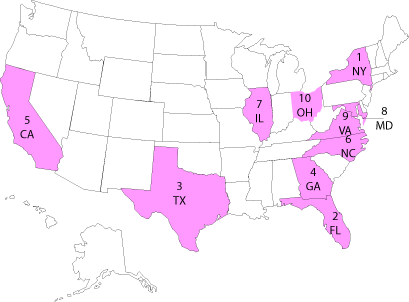African American Profile

(Map of the US with the top 10 states displaying the
largest African American population according to the Census Bureau)
NY - CA - TX - GA - FL - NC - IL - OH - MD - VA
Overview (Demographics): In July 2011, 43.8 million people in the United States, or 14 percent of the civilian noninstitutionalized population, were Black. They are the second largest minority population, following the Hispanic/Latino population. In 2010, the many Blacks lived in the South (20 percent), while 36 percent of white population lived in the South. The ten states with the largest Black population in 2010 were New York, Florida, Texas, Georgia, California,North Carolina, Illinois, Maryland, Virginia, Ohio. Louisiana is no longer in the top 10, as a result of the Hurricane Katrina disaster. Combined, these 10 states represented 58% of the total Black population. Of the ten largest places in the United States with 100,000 or more population, Detroit, Michigan has the largest proportion of Blacks, 84%, followed by Jackson, Mississippi (80%).Educational Attainment: In 2010, as compared to Whites 25 years and over, a lower percentage of Blacks had earned at least a high school diploma (82 percent and 91 percent, respectively). More Black women than Black men had earned at least a bachelor's degree (19.8 percent compared with 15.7 percent), while among non-Hispanic Whites, a higher proportion of men than women had earned at least a bachelor's degree (32 percent and 31 percent, respectively).
Economics: According to the 2010 Census Bureau report, the average African-American family median income was $39,988 in comparison to $67,892 for non-Hispanic White families. In 2010, the U.S. Census bureau reported that 27.1 percent of African-Americans in comparison to 10.6 percent of non-Hispanic Whites were living at the poverty level. For 2011, the unemployment rate for Blacks was twice that for non-Hispanic Whites (15.8 percent and 7.9 percent, respectively). This finding was consistent for both men and women.
Insurance Coverage: In 2010, 44 percent of African-Americans in comparison to 62 non-Hispanic Whites used employer-sponsored health insurance. Also in 2010, 28 percent of African-Americans in comparison to 11 percent of non-Hispanic Whites relied on Medicaid, public health insurance. Finally, 20.8 percent of African-Americans in comparison to 11.7 percent of non-Hispanic whites were uninsured.
Full Census Reports:
The Black Population: 2010 [PDF | 2.9MB]
The Black Population in the United States: March 2002 [PDF | 71KB]
The American Community Survey - Blacks: 2004 [PDF | 915KB]
Census Bureau, 2011. Income, Poverty, and Health Insurance Coverage in the United States: 2010 [PDF | 2.3MB]
Health Conditions: In 2009, the death rate for African Americans was higher than Whites for heart diseases, stroke, cancer, asthma, influenza and pneumonia, diabetes, HIV/AIDS, and homicide.
Quick Facts - See the following links for detailed statistics on specific health conditions:
All Topics A-Z
Diabetes
Heart Disease
HIV/AIDS
Immunization
Infant Mortality
Stroke
You will need Adobe Acrobat® Reader™ to view PDF files located on this site. If you do not already have Adobe Acrobat® Reader™, you can download here for free.





 FYI ...
FYI ... Keep Informed!
Keep Informed! Need Help?
Need Help?